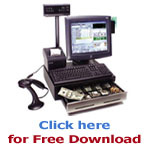Can RFID tags in consumer products be deactivated before the customer leaves the store?
Yes. This is known as the “kill” command. The reader sends a code to the tag that turns the tag off permanently. When RFID systems are fully deployed in stores and most products have RFID tags in their packaging (this won’t happen for at least 10 years), each checkout counter will likely have an RFID reader that can kill the tags. In the mean time, companies will likely place kiosks near the exits of stores, so consumers who wish to can kill the tags. Products will have symbols indicating that the package contains a tag and retailers may remove the tags at the time of checkout if consumers want them removed.
How big are RFID transponders?
RFID transponders range in size from the size of a grain of pepper to the size of a brick. The size depends on whether the tag uses a battery to broadcast a signal or simply reflects a signal back from the reader. The other factor is the size of the antenna. As the antenna gets smaller the read range decreases. Tags that are the size of a grain of pepper have an antenna etched onto the microchip. Because the antenna is so small, the tags can only be read from less than an inch away.
Can tags be reactivated?
EPCglobal, the nonprofit organization that is developing standards for the use of EPC technology, has stipulated that all EPC tags should have a feature that enables them to be rendered permanently inoperably by the kill command. This is to prevent anyone from reactivating a tag and using it to track a person without their knowledge. It’s always possible that a design flaw is discovered which enables someone to reactivate a tag. No such flaw is known to exist at this time.
Can RFID tags be hidden in consumer products?
RFID tags can be read through non-metallic packaging so they can be embedded in products and product packaging. However, it’s unlikely that companies would try to hide tags in their products, since these would be easy to discover. A consumer could use a reader to locate the tag.
Are there any consumer benefits to RFID? Or do all the benefits go to the companies that use it?
There are many consumer benefits. Greater efficiency in the supply chain will reduce costs and improve efficiencies. Companies will pass some of these savings on to consumers to try to gain market share from less efficient competitors. RFID could be used by retailers to expedite returns and by manufacturers to manage warrantee claims and improve after-sales support of items such as computers and DVD players. RFID could also reduce the counterfeiting of pharmaceutical drugs and insure the integrity of products purchased by consumers. And RFID could be used to secure the food supply and prevent terrorists from sneaking weapons of mass destruction into a country through shipping containers.
Can RFID be embedded in money?
It’s possible but so far, no country has used RFID tags in this way. Hitachi, the Japanese high-technology company, has developed a very tiny RFID chip, called the mu-chip, designed to help governments prevent the counterfeiting of passports, securities and other documents. There have been reports that the European Union and Japan are considering embedding these chips in large bills, but officials of the EU Bank and the Bank of Japan told RFID Journal that they had no plans to use RFID in bills as of mid-2004. Even if it is technically possible, it’s not clear that the benefits would outweigh the huge costs of the infrastructure needed to make RFID an effective anti-counterfeiting tool. Also, there would likely be strong opposition from privacy advocates (as well as companies that do business mostly in cash














